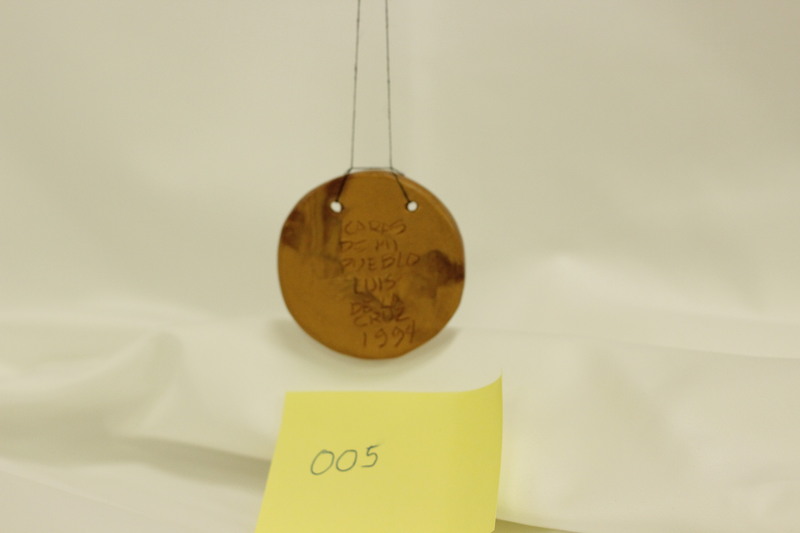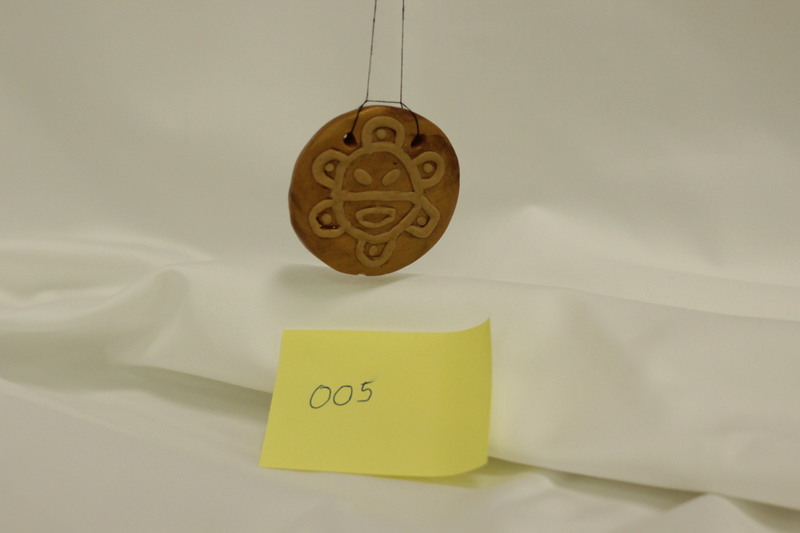Taino Sun Cemi Necklace
Title
Subject
Taino Indians—Antiquities
Taino art
Description
This object is a necklace, and originally the decoration on the front would have been carved into a rock or painted or drawn on a cave wall. In recent history, the Cemi symbols have been used as decorative pieces to represent the traditional Taino native culture that was indigenous to Puerto Rico before the arrival of the Spanish Colonizers.
The Taino peoples are the indigenous population to the Greater Antilles, and specifically to Puerto Rico. The Taino people lived and thrived before the arrival of the European colonizers around 1500 AD. Part of the Taino culture has to do with Cemis, Cemis themselves are not the object that represent them, but a vital force that creates changes. Cemi can be referred to as a state of being. The original purpose for the Cemis that were carved into rocks, or painted on cave walls is still unknown to this day, many archeologists and other social scientists believe that they Cemis could have been used for ceremonial purposes, to represent the deities, to symbolize power or position in society, or to represent plants or animals for worship (Caciques and Cemi Idols The Web Spun by Taino Rulers Between Hispaniola and Puerto Rico).
Like many cultures songs, dance and celebration is a vital part to Taino culture. During ceremonial events food would be offered to the Cemi, which is spirit, many of these ceremonies involved music and dancing (Talking Taino Caribbean Natural History from a Native Perspective.). Music and dancing which was important for the spiritual aspect of the Taiino people’s religion is still important to the Puerto Rican people today. Music can be traced back through the development of the Puerto Rican culture in the United States today.
The celebratory song and dance that is believed to be a common practice around the worship of the Cemi idols has been morphed into hip-hop and street dancing. Juan Flores writes in the book From Bomba to Hip-Hop : Puerto Rican culture and Latino identity, children of parents who were colonial immigrants used rap and breakdancing to express their feelings and emotion. The music grew and evolved off the previous generation style and techniques, linking themselves back to the indigenous Puerto Rican and Caribbean island Taino traditions. The Latino community adopted traditions from other cultures and imbed the new ideas into their own creating a culture which is seen today through the links of music and dance.
Even though parts of the Puerto Rican and larger Latino population culture has become blended with the culture of the United States, many Latinos still hold on to the artifacts and symbols of the Cemi from the indigenous Island Taino culture to remember where their ancestors came from and the roots in Puerto Rico and the other Caribbean islands they still hold dear to themselves. This link with the home islands creates an environment where the Puerto Rican population travels back and forth from the United States to Puerto Rico. The cities in the United States in which many Puerto Ricans settled, according to Virginia Sanchez Korrol, directly reflected the ones they had left behind on the island. This link to the island through direct recreation of what the immigrants left behind links to the attempt to remember the pre-Spanish colonization which occurred in the Greater Antilles in the late 1400’s and early 1500’s. The Cemi idols today represent the knowledge that Puerto Rican, and the Caribbean Islands had their own indigenous culture before the Spanish colonization. The idols also show similarities between the indigenous Taino culture to the current day Latino cultures in North America.
The Cemi idols represent a spirituality and the life force, that is visible in the Latino and Puerto Rican population today through music and culture. Some people still try to preserve the link to the indigenous Taino peoples by continuing to practice the cultural and religious aspects around the Cemi idols, even though they were believed to be extinct ("Taino Culture Lives").
This particular necklace was given to Mr. Marrero by his mother; he believes she purchased it at a bazaar. It serves as a reminder of his ties to indigenous Puerto Rican culture and to the memories and warmth of the Puerto Rican sun. He keeps it on display with other memorabilia in his home. It is not uncommon for Puerto Rican children living on the mainland to receive this from an older relative to help connect them to his/her culture.
Flores, Juan. From Bomba to Hip-hop : Puerto Rican Culture and Latino Identity. Popular Cultures, Everyday Lives. New York: Columbia University Press, 2000.
Harline, Jo Lynne. "Taino Culture Lives." Archaeology 64, no. 1 (2011): 8. http://www.jstor.org/stable/41780639.
Keegan, William F., and Lisabeth A. Carlson. Talking Taino Caribbean Natural History from a Native Perspective. Caribbean Archaeology and Ethnohistory. Alabama: University of Alabama Press, 2010.
Korrol, Virginia E. Sanchez. From Colonia to Community: The History of Puerto Ricans in New York City. Berkeley: University of California Press, 1983.
Oliver, Jose R, & Oliver, José R. (2009). Caciques and Cemi Idols The Web Spun by Taino Rulers Between Hispaniola and Puerto Rico (Caribbean Archaeology and Ethnohistory). Tuscaloosa: University of Alabama Press.
Creator
Source
Publisher
Date
Accession Date: April 6, 2017

